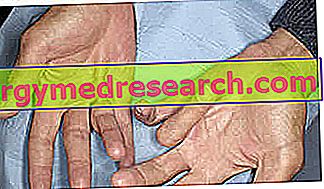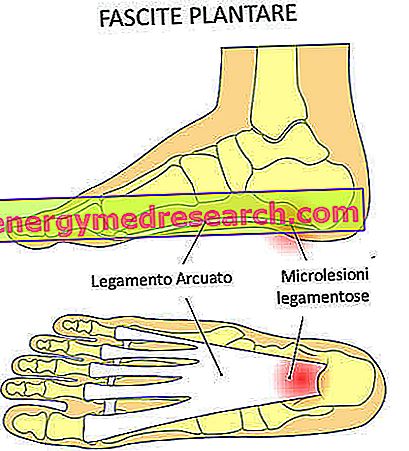Generality
Dupuytren 's disease is a disease that affects the hand, resulting in the permanent curvature of one or more fingers and the appearance of a variable number of nodules in the palm of the hand.

The most serious patients have difficulty in holding objects and carrying out the most normal manual activities, such as driving.
The diagnosis is simple, as the pathological signs are unequivocal.
From a therapeutic point of view, the solutions are different and depend on how severe the symptoms are: in moderate cases, the doctor opts for a non-surgical treatment, while in the more severe ones he suggests surgery.
Anatomy of the hand
From the anatomical point of view, the hand is defined as the most distal point of the upper limb. When it is completely open (ie with the fingers extended), the hand has two faces: the so-called palm of the hand, which is the front face, and the so-called back of the hand, which represents the back face.
BONE ANATOMY

Figure: seat (in the red circle) of the aponeurosis or palmar band. It can be seen that it is in continuity with the tendons of the fingers.
From the point of view of the bone anatomy, the hand has a carpus, formed by 8 bones, a metacarpus, composed of 5 long bones, and 14 phalanges, that is, the bones of the fingers.
WHAT IS PALMAR APONEUROSIS?
To understand the causes of Dupuytren's disease, it is essential to know what the palmar aponeurosis is, also known as the palmar fascia .
The palmar aponeurosis is a thin sheet of connective tissue and collagen, located at the palm of the hand, just below the skin surface. Similar, for histological characteristics, to the tendons of the fingers, it also has the same elastic properties as the latter and represents their continuity.
The subcutaneous position causes the palmar aponeurosis to cover the main muscles of the palm of the hand and the blood vessels passing through that region.
What is Dupuytren's disease?
Dupuytren's disease, also known as Dupuytren's contracture, is a disease affecting the hand, which causes the permanent flexion (or curvature) of one or more fingers towards the so-called palm of the hand.
The disease can affect one or both hands and can affect any finger, including thumb.
IS IT SERIOUS?
Dupuytren's disease is also characterized by the formation, at the level of the palm of the hand, of a conglomerate of rigid consistency.
Composed of connective tissue and collagen, this agglomerate (or nodule ) is equivalent to a benign tumor, totally harmless to those who suffer from it. The only drawback to note is the fact that this nodule can become very annoying and prevent various manual activities.
Epidemiology
Dupuytren's disease is a typical disease of the middle-advanced age: it usually affects people between the ages of 50 and 60, while it is very rare among young people.
He also has a marked preference for male individuals and the populations of Northern Europe ; this last feature seems to be somehow connected to a genetic factor, present within the people coming from this area of the continent.
Pathological conditions associated with Dupuytren's disease:
- Garrod bearings . It is a disease that affects the knuckles of the fingers
- Ledderhose disease, or plantar fibromatosis . It is very similar to Dupuytren's contracture, only that it affects the feet
- Peyronie's disease
Causes
To cause the permanent flexion of one or more fingers is the localized thickening of the palmar aponeurosis, which leads first to the formation of a nodule, then to the loss of elasticity of the connective tissue and finally to the shortening of the neighboring tendons of the fingers.

Figure: Dupuytren's nodules are created by a thickening of the connective tissue of the palmar aponeurosis.
In other words, Dupuytren's disease occurs when the connective tissue of the palmar aponeurosis thickens, shortening the tendon or the tendons of the nearest fingers.
But what triggers this process?
Although there is still a lack of certain evidence on the subject, many researchers claim that there are genetic factors at the origin of everything.
GENETIC THEORY
People with Dupuytren's disease often have very close family members (parents or siblings) suffering from the same pathology. This led the researchers to consider the hypothesis that the disease has a genetic-hereditary origin.
According to some studies (which deserve to be investigated), the gene involved appears to be located on an autosomal (or non-sexual) chromosome and Dupuytren's disease would belong to the category of so-called autosomal dominant genetic diseases .
Dupuytren's disease and its spread in Northern Europe
Dupuytren's disease is also commonly called " viking disease ", as it is widespread among Northern European populations ( Scandinavia ). This statistical datum is very interesting, as it supports the aforementioned genetic hypothesis and the fact that the disorder is transmitted between blood relatives.
FAVORABLE CONDITIONS
After several statistical surveys, the researchers observed that Dupuytren's disease is more frequent among:
- People with diabetes . Diabetes is a serious disease, characterized by high levels of glucose in the blood ( high blood sugar ).
- People who routinely use anticonvulsants for the treatment of epilepsy .
- People who take large quantities of alcohol .
- Big smokers .
- Those who have suffered a severe trauma to the hand, precisely on the wrist.
Such recurrences could be related to the appearance of the pathology (therefore not random), although it should be remembered that, among patients with Dupuytren's disease, also people not belonging to the categories listed above are included.
Do manual work affect the appearance of Dupuytren's disease?
The onset of Dupuytren's disease does not appear to be related either to manual work or to works involving the use of vibrating instruments.
Symptoms
To learn more: Symptoms Dupuytren's disease
Dupuytren's disease is distinguished by the appearance, on the palm of the hand, of one or more nodules (whose diameter can even reach one centimeter), which can be associated with the permanent flexion of one or more fingers.
The nodules derive from the thickening of the connective tissue that constitutes the palmar aponeurosis; flexion of the fingers, on the other hand, is due to the presence of the same nodules, which shorten and tend to pull the tendons of the fingers towards the palm of the hand.
Beside these two characteristic signs, the patient can complain (always in correspondence with the palm of the hand) of pain, itching, soreness and difficulty in gripping the objects .
The fingers usually affected by Dupuytren's disease are the ring finger and the little finger, although, in reality, the disorder can also affect the middle finger and the thumb.
The formation of pathological nodules can affect one or both hands.
THICKENING, NODULES AND FLEXURE OF FINGERS
The thickening of the connective tissue and the nodules are recognizable by touch and sometimes even by sight. Their appearance is due to the hyperactivity of particular cells, called fibroblasts, which produce an excess of collagen (protein present in abundance in the connective tissue of the palmar aponeurosis).
The process that leads the nodule to shorten the neighboring tendons takes months, if not years. At the end of the thickening and shortening processes, the patient is no longer able to straighten the affected fingers, therefore the flexion is permanent.
EFFECTS ON MANUAL CAPACITIES
Dupuytren's disease, at an advanced stage, can prevent the correct handling of objects and the practice of various manual and sports activities, such as:
- Shake a salt shaker
- Playing a musical instrument
- To drive
- Hold the cutlery
- To swim
WHEN TO REFER TO THE DOCTOR?
It is good to contact your doctor at the first signs of a thickening or a lump, so as to be promptly entrusted to a hand specialist, who knows what to do in certain situations.
Continue: Dupuytren's disease - Diagnosis and Care »



